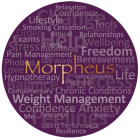Phobias
word definitions taken from Wikipedia
A phobia (from the Greek: φόβος, Phóbos, meaning “fear” or “morbid fear”) is a type of anxiety disorder, usually defined as a persistent fear of an object or situation in which the sufferer commits to great lengths in avoiding, typically disproportional to the actual danger posed, often being recognized as irrational. In the event the phobia cannot be avoided entirely the sufferer will endure the situation or object with marked distress and significant interference in social or occupational activities.
The terms distress and impairment as defined by the Diagnostic and Statistical Manual of Mental Disorders, Fourth Edition (DSM-IV-TR) should also take into account the context of the sufferer’s environment if attempting a diagnosis. The DSM-IV-TR states that if a phobic stimulus, whether it be an object or a social situation, is absent entirely in an environment – a diagnosis cannot be made. An example of this situation would be an individual who has a fear of mice (Suriphobia) but lives in an area devoid of mice. Even though the concept of mice causes marked distress and impairment within the individual, because the individual does not encounter mice in the environment no actual distress or impairment is ever experienced.
Proximity and the degree to which escape from the phobic stimulus should also be considered. As the sufferer approaches a phobic stimulus, anxiety levels increase (e.g. as one gets closer to a snake, fear increases in Ophidiophobia), and the degree to which escape of the phobic stimulus is limited and has the effect of varying the intensity of fear in instances such as riding an elevator (e.g. anxiety increases at the midway point between floors and decreases when the floor is reached and the doors open).
Finally, a point warranting clarification is that the term phobia is an encompassing term and when discussed is usually done in terms of specific phobias and social phobias. Specific phobias are nouns such as arachnophobia or acrophobia which, as the name implies, are specific, whereas social phobia are phobias within social situations such as public speaking and crowded areas.
Clinical phobias
Psychologists and psychiatrists classify most phobias into three categories and, according to the Diagnostic and Statistical Manual of Mental Disorders, Fourth Edition (DSM-IV), such phobias are considered to be sub-types of anxiety disorder. The three categories are:
Social phobia – fears involving other people or social situations such as performance anxiety or fears of embarrassment by scrutiny of others, such as eating in public. Overcoming social phobia is often very difficult without the help of therapy or support groups. Social phobia may be further subdivided into generalized social phobia (also known as social anxiety disorder or simply social anxiety) and specific social phobia, in which anxiety is triggered only in specific situations.
The symptoms may extend to psychosomatic manifestation of physical problems. For example, sufferers of paruresis find it difficult or impossible to urinate in reduced levels of privacy. This goes far beyond mere preference: when the condition triggers, the person physically cannot empty their bladder.
Specific phobias – fear of a single specific panic trigger such as spiders, snakes, dogs, water, heights, flying, catching a specific illness, etc. Many people have these fears but to a lesser degree than those who suffer from specific phobias. People with the phobias specifically avoid the entity they fear.
Agoraphobia – a generalized fear of leaving home or a small familiar ‘safe’ area, and of possible panic attacks that might follow. It may also be caused by various specific phobias such as fear of open spaces, social embarrassment (social agoraphobia), fear of contamination (fear of germs, possibly complicated by obsessive-compulsive disorder) or PTSD (post traumatic stress disorder) related to a trauma that occurred out of doors.
Phobias vary in severity among individuals. Some individuals can simply avoid the subject of their fear and suffer relatively mild anxiety over that fear. Others suffer full-fledged panic attacks with all the associated disabling symptoms. Most individuals understand that they are suffering from an irrational fear, but they are powerless to override their initial panic reaction.
How can Morpheus Associates help?
Hypnotherapy is used successfully to help people deal with a wide range of conditions. It is widely recognised now in its success with helping people with relaxation, and techniques are used to help people manage stress and anxiety associated with many other conditions. The client normally awakes feeling re energised and revitalised, with new hope and a positive frame of mind.
We offer an Initial 15-20 minute consultation which is free. At the end of this consultation you will be asked if you wish to proceed. At which point we will explain the fees per session, relevant to the treatment recommended and how many sessions are suggested as being required. We are located at Clarice House in Ipswich, The Heritage Centre Bury St Edmunds, Clarice House Colchester and Harley Street London. If a course of treatment is recommended, subsequent sessions are offered at a discounted price. Payments are accepted by cash or cheque with guarantee card only.
Please feel free to read our recent testimonials (link) from clients who have had this condition treated by Morpheus Associates
If you are comfortable with the idea, please call us to book an Initial 15-20 minute consultation, at which time you can decide if you feel the treatment offered would possibly help. Call Debbie Crooks on 07840-694743.

